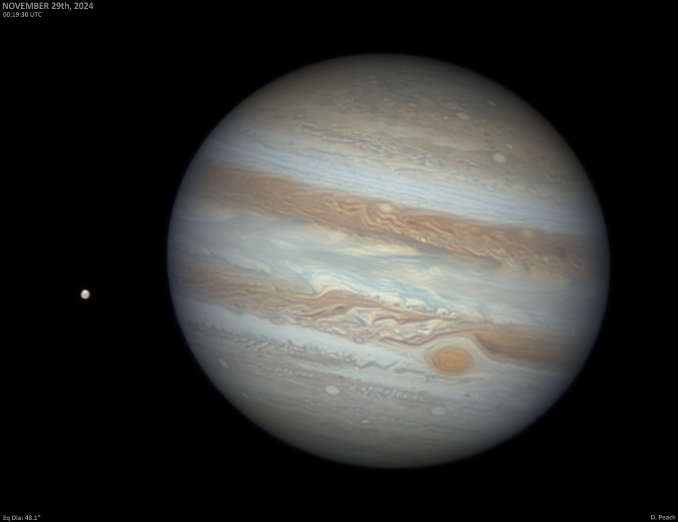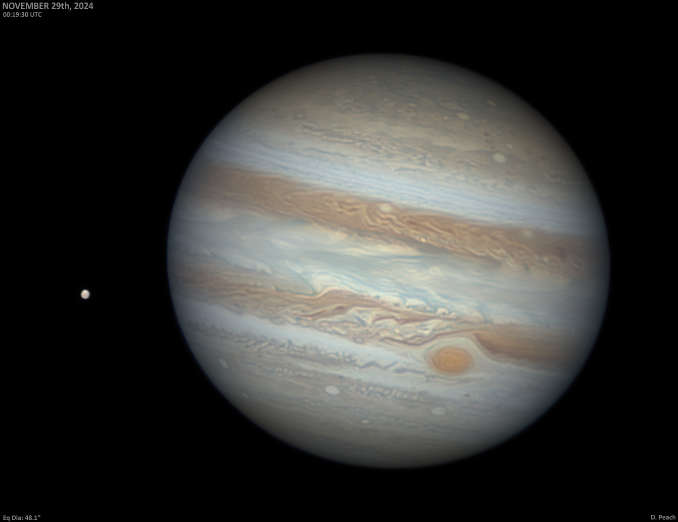Now Reading: Jupiter Shines Brightly in Taurus During December Opposition
-
01
Jupiter Shines Brightly in Taurus During December Opposition
Jupiter Shines Brightly in Taurus During December Opposition


Brilliant Jupiter, the majestic king of planets, shines resplendently in the constellation Taurus this December, marking a celestial event that captures the attention of amateur and professional astronomers alike. With its opposition occurring on 7 December, Jupiter reaches a zenith in both visibility and spectacle, making this an extraordinary time for sky watchers.
As Jupiter lies in Taurus, it boasts an impressive declination of just over 22 degrees, positioning it high in the northern sky, a sight that has not been this favorable in over a decade. The last time Jupiter was this well-placed was in 2011, and the next opportunity for such a viewing will not come until 10 January 2026, when it transitions into Gemini.
At magnitude –2.8, Jupiter’s brilliance dwarfs nearby stars, outshining even Sirius, the brightest star in our night sky. Observing Jupiter this month reveals its striking disk, measuring approximately 48.1 arc seconds across—almost three times the size of Saturn’s globe. The sheer size and brightness of Jupiter make it an unmistakable object, even in the light-polluted skies of urban settings.
On the night of opposition, Jupiter rises at 3.45 PM GMT from London, reaching 30 degrees high by 7.15 PM and culminating at 11.50 PM, appearing at an impressive elevation of between 56 and 61 degrees. For night owls, the opportunity to observe this gas giant is extended until at least 4:30 AM, providing over nine hours of celestial viewing. With Jupiter remaining above 30 degrees in elevation from 5:30 PM to 2:30 AM, that is an excellent opportunity for imaging and observation.
Equipped with a pair of 10 x 50 binoculars, observers can discern Jupiter’s notable disc and appreciate its rapid rotation, which gives the planet a distinctive bulging appearance at its equator. This rotation period lasts about nine hours and 50 minutes, offering dynamic visuals throughout the night as the gas giant’s features shift continually.
One of the most compelling aspects of Jupiter is its four Galilean moons: Io, Europa, Ganymede, and Callisto. Since their discovery by Galileo in 1610, these moons have provided endless fascination as they orbit around their parent planet. With magnitudes ranging between fifth and sixth, these moons are accessible to even casual observers and can be readily seen with binoculars.
Using a telescope, even a modest 60mm aperture, allows viewers to appreciate the intricate details of Jupiter’s atmosphere, including its famous dark belts and bright zones. The predominant features, such as the North and South Equatorial Belts, become evident, showcasing the gas giant’s turbulent weather systems. Additionally, the Great Red Spot, a colossal storm persisting for nearly 350 years, continues to captivate observers. Its shrinking diameter—from over 40,000 kilometers in the 19th century to just over 15,000 kilometers today—serves as a reminder of the planet’s dynamic nature.
| Feature | Description |
| Magnitude | –2.8 |
| Disc Size | 48.1 arc seconds |
| Rotation Period | Approximately 9 hours and 50 minutes |
| Galilean Moons | Io, Europa, Ganymede, Callisto |
| Great Red Spot Diameter | About 15,000 kilometers |
The upcoming events in Jupiter’s celestial dance, particularly around 10 December, will be especially noteworthy. Io and its shadow will transit on this date, providing a stunning sight for observers. The shadow events—where the moons glide across or disappear behind Jupiter—are fascinating phenomena that can be appreciated even with smaller telescopes. These intricate dances between the moons and their shadows are not just celestial mechanics but a beautiful spectacle of nature that resonates deep within our understanding of the cosmos.
For those looking to enhance their observing experience, think using technology to track the moon’s activities and the Great Red Spot. Using mobile apps designed for amateur astronomers can provide real-time updates on the positions of Jupiter’s moons and their visibility, enabling viewers to plan their observations effectively.
The planetary alignment during opposition creates unique conditions; for example, transits of the moons often coincide with the Great Red Spot’s location on Jupiter’s surface. This alignment is a thrilling aspect for observers because it allows for the potential simultaneous viewing of these spectacular features.
As December unfolds, the sight of Jupiter in Taurus offers a rich tapestry of astronomical wonders. With the right equipment and a bit of planning, stargazers can revel in the beauty of our solar system’s largest planet, deepening their connection to the cosmos. So grab your binoculars or telescope and immerse yourself in this extraordinary celestial event.
Stay Informed With the Latest & Most Important News
Previous Post
Next Post
-
 012024 in Review: Highlights from NASA in Silicon Valley
012024 in Review: Highlights from NASA in Silicon Valley -
 02Panasonic Leica Summilux DG 15mm f/1.7 ASPH review
02Panasonic Leica Summilux DG 15mm f/1.7 ASPH review -
 03From Polymerization-Enabled Folding and Assembly to Chemical Evolution: Key Processes for Emergence of Functional Polymers in the Origin of Life
03From Polymerization-Enabled Folding and Assembly to Chemical Evolution: Key Processes for Emergence of Functional Polymers in the Origin of Life -
 04How New NASA, India Earth Satellite NISAR Will See Earth
04How New NASA, India Earth Satellite NISAR Will See Earth -
 05And Thus Begins A New Year For Life On Earth
05And Thus Begins A New Year For Life On Earth -
 06Astronomy Activation Ambassadors: A New Era
06Astronomy Activation Ambassadors: A New Era -
07SpaceX launch surge helps set new global launch record in 2024



















